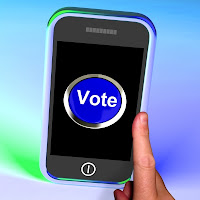The December 3 issue — yes, the one with the colorful fruits and vegetables on the covers supporting an article on What to Eat Now by the well-known Dr. Oz — had two articles that grabbed my attention. Unfortunately, neither article is available online unless you're a subscriber, but they both very matter-of-factly focused on how fast and how much social networking is changing our world. I mean I know this — I'm passionate about it and do it every day — but to see it in black and white next to world news, the AIDs epidemic in South Africa, and an article about the fiscal cliff.... I was immediately pulled in.
The first article, Friend Request. How the Obama campaign connected with young voters appeared in the Nation section: fair enough. If you've read some of the campaign post-mortems that I've read, you've seen that it wasn't the much-publicized Latino vote or female vote that swung the election for President Obama, but the youth vote — voters under 29. And it turns out that over half of the voters in that age group targeted in swing states didn't have landline phones, making the traditional last minute phone calls impossible.
Instead, the Obama campaign, a social-savvy team from day 1, built a Facebook application. (Are you thinking, "Of course they did!"? With the perfect vision hindsight gives us, I don't know why I was surprised.) It was rolled out to the more than one million Obama backers signed up. This app, like all Facebook apps, gave the campaign permission to look at the subscribers' Facebook friends. And communicating with this highly-valued, hard-to-reach target audience was made even easier because who do you trust more than your friends? Not some political campaign or advertiser. More than 5 million contacts were reached by the 600,000 Obama supporters who agreed to share messages. And so the campaign was won.
And the final word from TIME Magazine?
"In 2008, Twitter was a sideshow, and Facebook had about one-sixth its current reach in the U.S. By 2016, this sort of campaign-driven sharing over social networks is almost certain to be the norm. Tell your friends."
The second social-networking article that caught my eye was in the Health section, and titled, Crowdfunding a Cure. The sick are getting strangers to pay their medical bills. A quick glance at the sidebar shows you this headline: How This Cancer patient Raised $144,000.
I've been fascinated with the growth and potential of crowdfunding this year; writing a three-part series on the IBM Social Business Insights blog (Part 1, Part 2, Part 3). Instead of people raising money from their social circles for projects such as books, gadgets, CDs, or documentaries, crowdfunding sites such as GoFundMe and GiveForward enable patients and their families to raise thousands of dollars for medical treatments such as surgeries and cancer treatments that would otherwise be out of their reach.
 We're on the cusp of the most amazingly creative period in human history. Hyperbole? I don't think so. Worldwide collaboration, powered by social networking platforms, will give everyone a voice. Gender, age, ethnicity, language, location, education, ability — none of this will matter. Innovative companies like IBM will continue to pioneer enterprise-level collaboration platforms, enabling the worldwide, mobile, collaborative, inclusive workforce*. And consumer networking platforms, such as Facebook and Twitter and Kickstarter and GoFundMe and tumblr will continue to enable the collaboration and crowdsourcing that can help build a better world, for all of us.
We're on the cusp of the most amazingly creative period in human history. Hyperbole? I don't think so. Worldwide collaboration, powered by social networking platforms, will give everyone a voice. Gender, age, ethnicity, language, location, education, ability — none of this will matter. Innovative companies like IBM will continue to pioneer enterprise-level collaboration platforms, enabling the worldwide, mobile, collaborative, inclusive workforce*. And consumer networking platforms, such as Facebook and Twitter and Kickstarter and GoFundMe and tumblr will continue to enable the collaboration and crowdsourcing that can help build a better world, for all of us.Now truly, doesn't that just make your day? :-)
*Full disclosure — I am an IBM employee, and totally amazed by the forward-thinking creativity that goes on at my company every single day.
"Vote Button On Mobile Screen" image courtesy of Stuart Miles / FreeDigitalPhotos.net
"Financial health" image courtesy of renjith krishnan / FreeDigitalPhotos.net
"Social Network" image courtesy of cooldesign / FreeDigitalPhotos.net


No comments:
Post a Comment